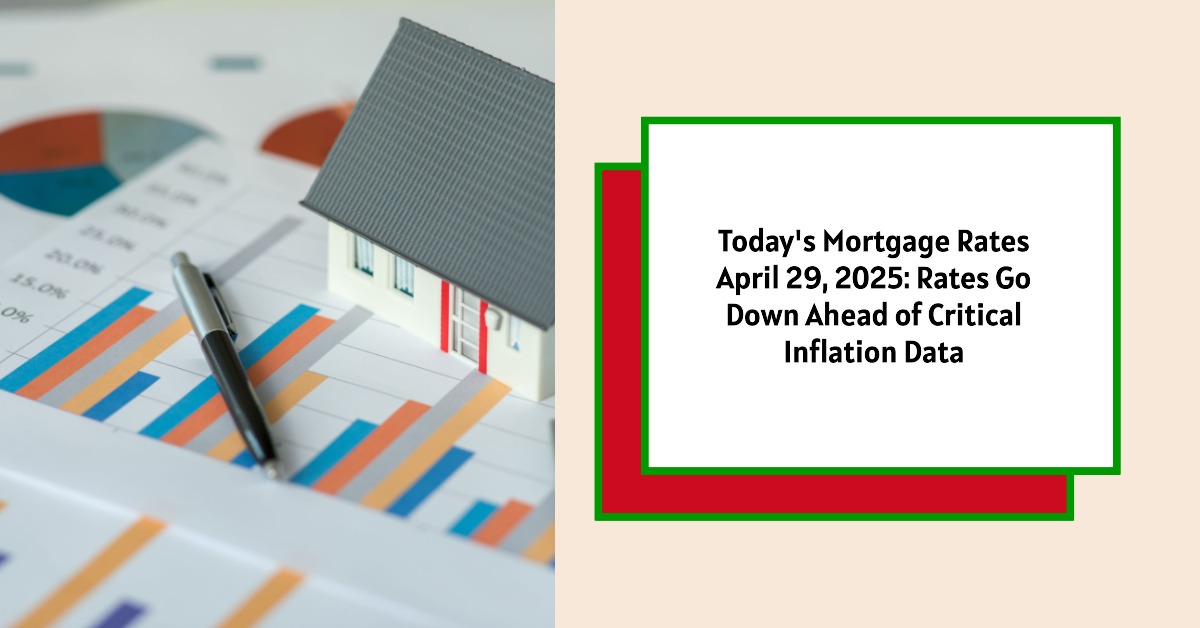As of April 29, 2025, mortgage rates are on a declining trend, making it an opportune time for potential homeowners and those looking to refinance. The average 30-year fixed mortgage rate has decreased to 6.64%, and the 15-year fixed rate is now at 5.95%. These reductions present promising prospects for affordability in monthly payments for home buyers and refinancing options. With the fluctuating mortgage landscape shaped by economic indicators, understanding these dynamics can significantly impact financial decisions.
Today's Mortgage Rates – April 29, 2025: Rates Dip Ahead of Critical Inflation Data
Key Takeaways:
- Current Mortgage Rates:
- 30-Year Fixed: 6.64%
- 15-Year Fixed: 5.95%
- 5/1 ARM: 6.99%
- 30-Year VA: 6.17%
- Refinance Rates:
- 30-Year Fixed: 6.67%
- 15-Year Fixed: 6.02%
- Economic Factors: Upcoming inflation reports may influence rate changes.
- Market Trends: Rates have dropped recently due to easing inflation concerns, but tariffs could create upward pressure.
Understanding the current mortgage rates is critical for making informed decisions when it comes to buying or refinancing a home. The mortgage market is sensitive to economic indicators, which can lead to fluctuations in interest rates. This article will delve deeper into the current mortgage and refinance rates, the factors influencing these rates, and what the future may hold for borrowers.
Current Mortgage and Refinance Rates
Today's rates highlight various financing options for those looking to buy or refinance a home. According to data from Zillow, here are the latest figures for mortgage and refinance rates:
| Loan Type | Current Rate | Change |
|---|---|---|
| 30-Year Fixed | 6.64% | ↓ 0.07% |
| 20-Year Fixed | 6.35% | N/A |
| 15-Year Fixed | 5.95% | ↓ 0.05% |
| 5/1 ARM | 6.99% | N/A |
| 7/1 ARM | 7.20% | N/A |
| 30-Year VA | 6.17% | N/A |
| 15-Year VA | 5.58% | N/A |
| 5/1 VA | 6.31% | N/A |
Today's Mortgage Refinance Rates
Refinancing provides current homeowners an opportunity to reassess their existing mortgage terms. Here's how the current refinance rates compare:
| Refinance Loan Type | Current Rate | Change |
|---|---|---|
| 30-Year Fixed | 6.67% | N/A |
| 20-Year Fixed | 6.33% | N/A |
| 15-Year Fixed | 6.02% | N/A |
| 5/1 ARM | 7.38% | N/A |
| 7/1 ARM | 7.48% | N/A |
| 30-Year VA | 6.20% | N/A |
| 15-Year VA | 5.92% | N/A |
| 5/1 VA | 6.34% | N/A |
The data displayed represents national averages, rounded to the nearest hundredth. However, actual rates may fluctuate based on individual borrower profiles, including credit scores, down payments, and loan-to-value ratios.
Understanding Mortgage Payment Structures in Depth
When evaluating mortgage options, it is essential to grasp the distinctions between various terms and financing structures. The most common options are the 30-year and 15-year fixed mortgages, which offer very different long-term financial implications.
30-Year vs. 15-Year Mortgages
Choosing between a 30-year and 15-year fixed mortgage can lead to vastly different financial outcomes. Below are in-depth insights into how each type stacks up in terms of monthly payments, interest over time, and total cost.
- 30-Year Fixed Mortgage:
- This loan allows lower monthly payments, making it ideal for buyers prioritizing affordability.
- While monthly payments are lower, the overall interest expense is significantly higher due to a longer repayment period.
- Example Calculation: For a $400,000 mortgage at a 6.64% interest rate, the monthly payment requires about $2,565 toward principal and interest. Over 30 years, this results in a staggering $523,476 in total interest paid.
- 15-Year Fixed Mortgage:
- This option entails higher monthly payments but results in significantly less interest paid over time.
- For buyers who can afford the higher monthly costs, it provides a faster path to home equity and ownership.
- Example Calculation: For the same $400,000 mortgage at a 5.95% interest rate, the monthly payment comes to approximately $3,365, leading to a total interest payment of around $205,634 over the life of the loan.
This comparison illustrates the financial trade-offs associated with different loan terms, affecting homeowners’ overall affordability and financial strategy.
Fixed-Rate vs. Adjustable-Rate Mortgages
When navigating mortgages, it is important to distinguish between fixed-rate mortgages and adjustable-rate mortgages (ARMs), each serving different financial needs.
Understanding Fixed-Rate Mortgages
- Fixed-Rate Mortgages:
- The interest rate for these loans remains constant for the entire duration of the loan term (30 years, 20 years, or 15 years).
- Borrowers enjoy predictable payments, which can simplify budgeting and financial planning.
- These loans are ideal for long-term homeowners seeking stability, especially in times of rising interest rates.
Understanding Adjustable-Rate Mortgages (ARMs)
- Adjustable-Rate Mortgages (ARMs):
- With ARMs, the interest rate is fixed for an initial period (e.g., 5, 7, or 10 years), after which it randomly adjusts based on market indices.
- Example: A 7/1 ARM maintains a fixed rate for the first seven years, then adjusts annually according to market conditions.
- They typically start with lower initial rates compared to fixed-rate mortgages, enticing borrowers. However, these come with the risk of adjustment, leading to potential increased costs down the line.
ARMs can be beneficial for those planning to move or refinance before the adjustment period, making them more attractive for individuals who seek lower short-term rates without long-term commitment.
Current Economic Influences on Mortgage Rates
Today’s mortgage rates do not exist in a vacuum; they are significantly influenced by a variety of broader economic factors. Below are key components driving these interest rates:
- Inflation Reports:
- Economic Indicators: Reports like the Personal Consumption Expenditures (PCE) price index are pivotal in determining inflation. A rise in inflation typically leads to an increase in mortgage rates, while a decrease can result in lower rates.
- The PCE data is particularly critical as it reflects changing consumer demand and pricing trends, serving as a primary gauge for the Federal Reserve's actions regarding interest rates.
- Federal Interest Rate Decisions:
- The Federal Reserve's adjustments to the federal funds rate can have direct consequences on mortgage rates, though not always immediately.
- The Fed has employed increases in the funds rate as a tool to counteract inflation throughout 2022 and 2023. In recent months, decreases in inflation have led to speculation about potential rate cuts.
- Market Reactions and Investor Sentiment:
- Investor confidence and demand for mortgage-backed securities play crucial roles in setting mortgage rates. If investors feel uncertain about economic winds, it may affect how they view mortgage securities and adjust interest rates in turn.
- Recent reductions in mortgage rates are reflective of easing concerns regarding tariffs, which had previously spurred market volatility.
Read More:
Mortgage Rates Trends as of April 28, 2025
Mortgage Rates Drop for the Second Day in a Row
When Will the Soaring Mortgage Rates Finally Go Down in 2025?
Why Are Mortgage Rates Rising Back to 7%: The Key Drivers
Looking Ahead: Future Trends in Mortgage Rates
Predicting future mortgage rates remains challenging due to unpredictable economic landscapes. While rates show a current downward trend, many factors could potentially reverse this momentum. Experts forecast that rates may stabilize around 6% over the next year or two, but they are unlikely to reach previous historic lows of less than 3% observed in 2020 and 2021.
- Upcoming Data Indicators:
- Labor market reports and GDP data are expected in the near future, which could sway lending rates regarding employment trends and economic growth.
- Economists are keeping a watchful eye on the implications of these reports since weaker data could prompt the Fed to reconsider its stance on interest rate adjustments.
- Inflationary Pressures:
- While the outlook appears cautiously optimistic regarding lower mortgage rates, inflation remains a critical concern. Tariff-induced inflation could resurface and increase the cost of borrowing, leading to potential rate hikes if the economy begins showing signs of overheating.
- Homebuyer Behavior:
- Changes in consumer preferences, such as the rising popularity of remote work, may continue to influence home buying trends which, in turn, can affect demand for mortgages. As locations change and buyers adapt, fluctuations in demand could further influence rates across various regions.
- Market Saturation and Competition:
- Increased competition among lenders for borrowers could also result in lower rates or better terms, making it essential for consumers to compare offers and seek competitive advantages during their mortgage application process.
Summary:
Navigating today’s mortgage market requires a thorough understanding of how interest rates function. The current trend of decreasing rates provides an advantageous position for potential buyers and those looking to refinance their homes. However, ongoing economic factors, particularly inflation and Federal Reserve policies, pose significant influences on future rate directions. Being informed about these critical elements can empower borrowers to make decisions that align with their financial goals, ultimately allowing them to secure the most beneficial mortgage terms available.
Turnkey Real Estate Investment With Norada
Investing in real estate can help you secure consistent returns with fluctuating mortgage rates.
Despite softer demand, smart investors are locking in properties now while competition is lower and rental returns remain strong.
HOT NEW LISTINGS JUST ADDED!
Speak with an investment counselor (No Obligation):
(800) 611-3060
Also Read:
- Will Mortgage Rates Go Down in 2025: Morgan Stanley's Forecast
- Expect High Mortgage Rates Until 2026: Fannie Mae's 2-Year Forecast
- Mortgage Rate Predictions 2025 from 4 Leading Housing Experts
- Mortgage Rates Forecast for the Next 3 Years: 2025 to 2027
- 30-Year Mortgage Rate Forecast for the Next 5 Years
- 15-Year Mortgage Rate Forecast for the Next 5 Years
- Why Are Mortgage Rates Going Up in 2025: Will Rates Drop?
- Why Are Mortgage Rates So High and Predictions for 2025
- Will Mortgage Rates Ever Be 3% Again in the Future?
- Mortgage Rates Predictions for Next 2 Years
- Mortgage Rate Predictions for Next 5 Years
- Mortgage Rate Predictions: Why 2% and 3% Rates are Out of Reach
- How Lower Mortgage Rates Can Save You Thousands?
- How to Get a Low Mortgage Interest Rate?
- Will Mortgage Rates Ever Be 4% Again?


